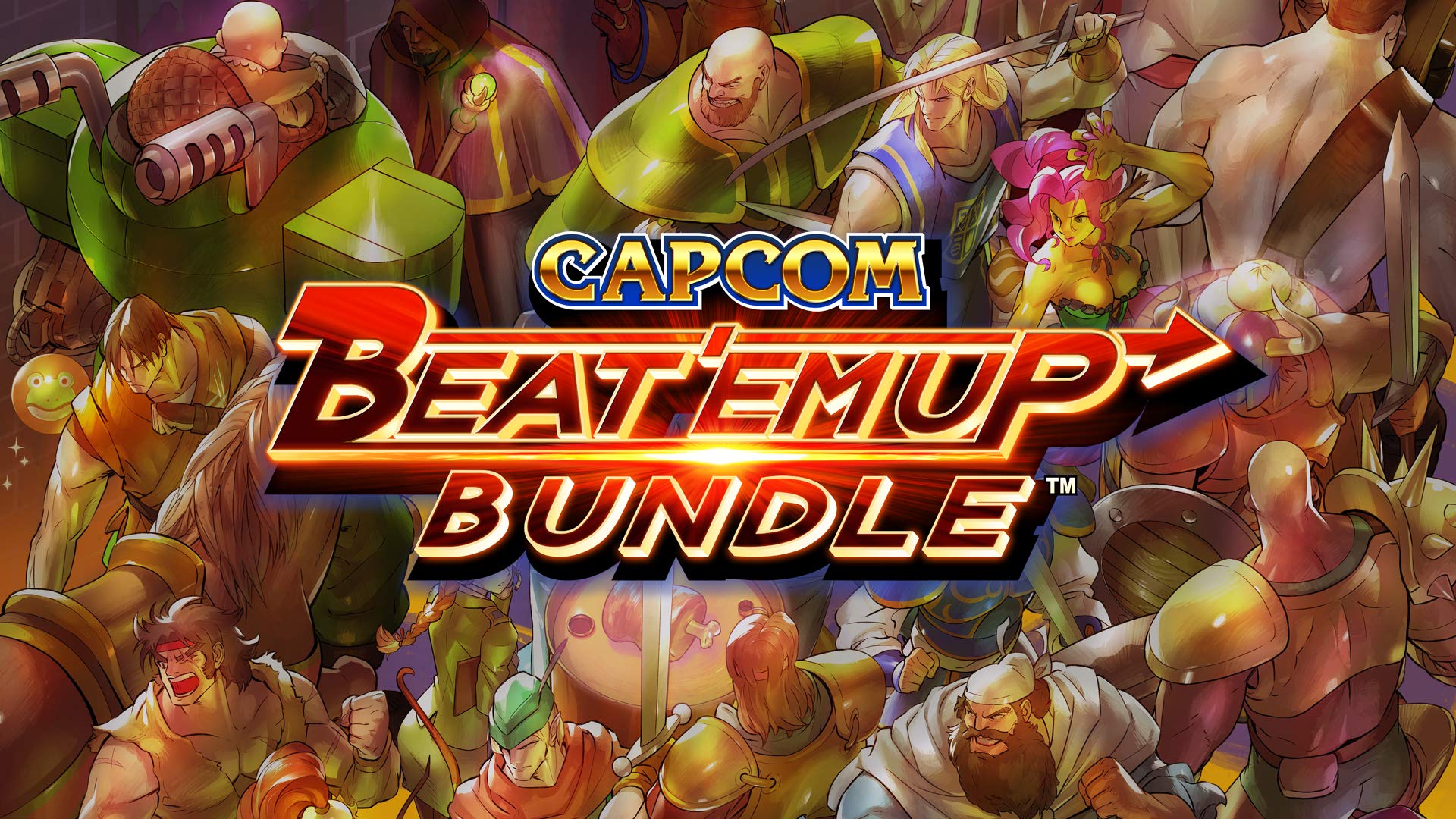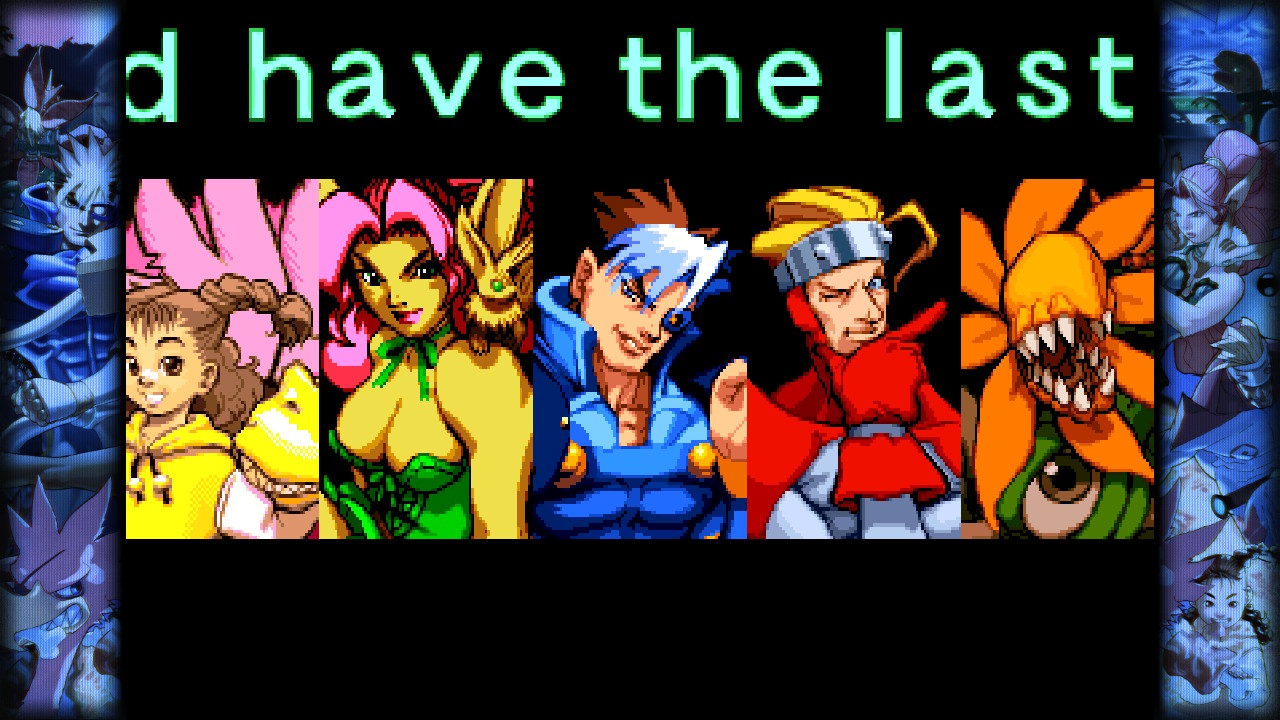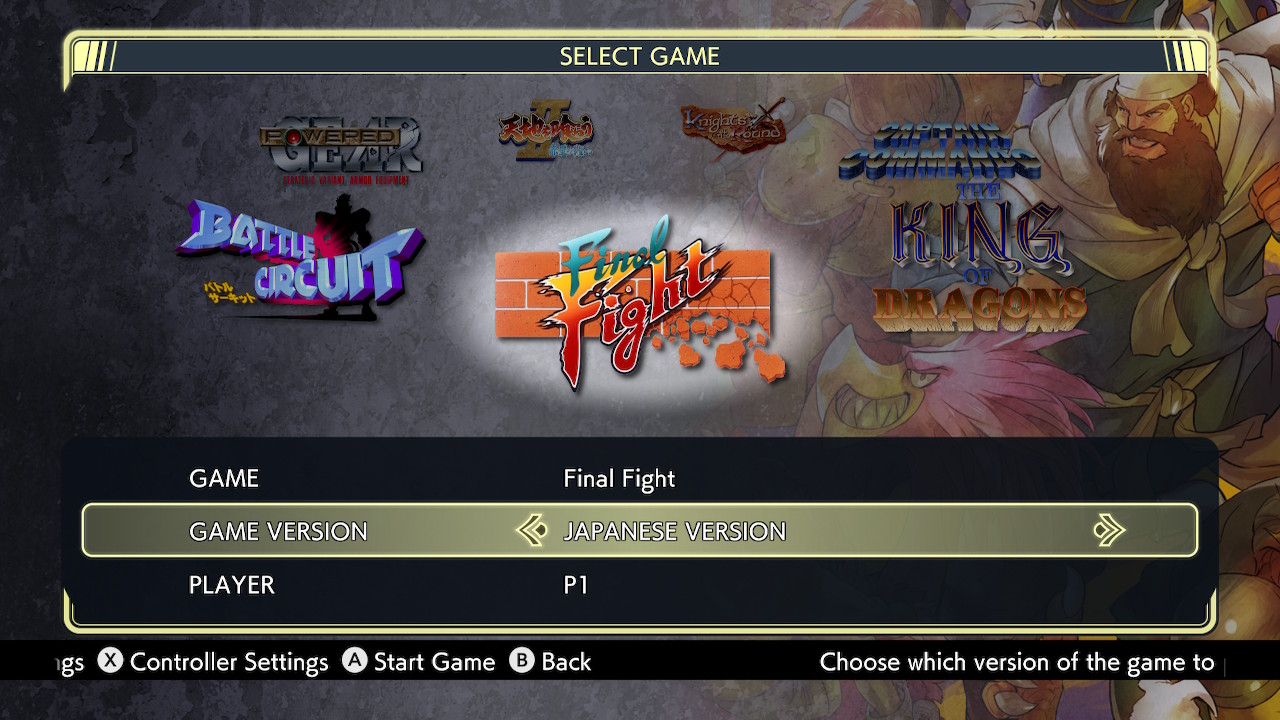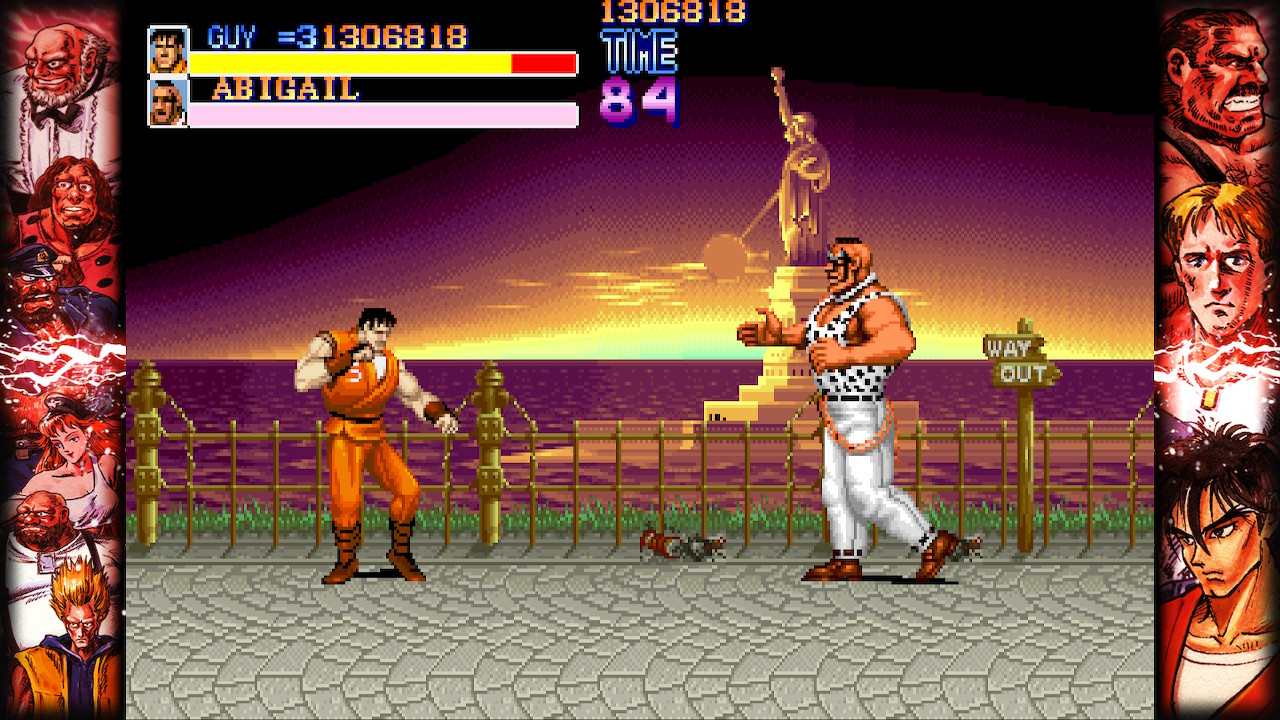Capcom Beat 'Em Up Bundle review
You might not know this about me, but I’m a big fan of old school beat’em up games. TMNT, Double Dragon, Final Fight, River City Ransom; I kinda love all of them. Final Fight in particular—with its Street Fighter connections and best-character-ever Guy—is definitely a favorite of mine. So when Nintendo announced Capcom Beat’Em Up Bundle I was the middle-aged dude voice you heard squealing with glee.
Immediately buying the Bundle and jumping right in, I was not disappointed. You see, this a collection of old arcade games, and these particular titles aren’t hard to find online if you wanted to emulate them. (In fact, this collection is missing some of Capcom’s best beat’em ups due to licensing issues, so you might still want to go the emulation route in order to play those gems.) But having the official release primed and ready to go on the Switch—especially for muliplayer purposes—is something I couldn’t possibly pass up. And having spent a good amount of time with the Bundle, I am happy to report that it’s pretty damn sweet.
First of all, it must be said that the menus, bonus materials, and overall presentation is very slick and I definitely appreciate it. Once again, the Museum mode included in this game is worth the price of admission alone. The collection of artwork and design documents curated here is pretty damn impressive, and I can get lost flipping through page after page of historical materials. Seriously, I love this stuff.
Regarding the games themselves, these are the original arcade roms playing in all their glory. Several of these titles had home console releases on the SNES, but audio/visual quality had to be paired down to fit on the less beefy hardware. That said, despite the experience being “arcade perfect” here, you may find the sound quality lacking for a few titles. Turns out audio has improved a lot in 20-30 years! So I recommend turning the volume down a few notches.
Most of these games can be played with three players max, but Captain Commando and Battle Circuit actually offer four-player modes. Final Fight, being the grand daddy of the bunch, is only two-player.
The option to play either the US or Japanese versions of each game is greatly appreciated.
Most games can be played in different modes (2-player and 4-players, for example), and there a multiple difficulty/lives settings to mess with, kind of like the dip-switches arcade operators could adjust back in the day. Player controls are fully configurable, which is especially handy on Switch because there’s just a ton of controller options to choose from.
But my favorite inclusion here is the option to select either the US or Japanese version of each game. The will affect not only in-game story text, but in some games changes visual affects, like blood that was censored for American audiences. In the case of Warriors of Fate/Tenchi wo Kurau II, the title, setting, and all characters names are completely different between versions. It’s fair to assume this collection features at least two roms for each game; one for each region selectable.
Ok, let’s take a look at each game and see what they have to offer.
Final Fight (1989)
Oh man, I freaking love Final Fight! Mike has never understood why I love this game so much, but it’s awesome. And now you can play through the entire arcade classic, with no visual downgrades or character name changes, for the first time ever on a Nintendo console. Finally, Roxy and Poison can trade blows with the fellas.
The journey through Metro City, beating wave after wave of street punks into submission, is so rad. It’s like being in an 80’s action movie and exudes a 1989 vibe all the way. Pick one of three manly protagonists: Cody - a street-smart tough guy whose girlfriend has been kidnapped, Haggar - a pro wrestler/mayor whose daughter has been kidnapped, or Guy - the coolest f#^king character ever, who’s only helping out because he knows Cody from the gym.
For more complete thoughts on this game, check out my review of Final Fight One for the Game Boy Advance.
Captain Commando (1991)
Basically a sci-fi comedy version of Final Fight—it’s even set in Metro City, but in the future!—with superhero protagonists. It’s also four-player. Running (by double-tapping right or left) has been added, as well as a dash attack to go with it.
The protagonist consist of the titular Captain Commando, a superhero with “Energy Gloves” allowing him to use lighting or fire in attacks; Ginzu (Shō in Japan), a ninja making hime the default coolest character, plus he supposedly uses Guy’s same Bushin-ryu style; Mack the Knife (Jennety in Japan), a knife-wielding mummy for some reason; and Baby-Head (Hoover in Japan) who’s—and I’m just going to quote Wikipedia directly here—“a super genius infant who fights using a robot of his own design". So yeah…this game is strange.
Everything is more over the top in Captain Commando. The cast of characters is obviously rather wacky. The weapons you can pick up include handguns, assault rifles, and missile launchers, upping the violence significantly. And there are mech suits you can jump into and wreak havoc, roasting enemies with flamethrowers or freezing them in blocks of ice. There’s a surprising amount of blood and characters getting cut in half too, at least in the Japanese version.
It seems like Capcom may have been trying to compete with Konami’s TMNT arcade games with this one. The Seaport level is eerily reminiscent of the sewer surfing levels. Enemies come out from under manholes to attack you. Enemies sometimes get dizzy from taking too many hits. Even the proliferation of mutant/monster enemies has a Ninja Turtles vibe.
One enemy, who I think is supposed be some kind of aquatic/diving soldier, has an outfit that is clearly referencing the Zenomorphs from Alien. Doppel, a boss character, shape-shifts into a copy of the character you’re playing as, which is a pretty cool gimmick.
The end boss, named Genocide, is the not only super generic, but he’s also probably the cheapest final boss character ever to appear in one of these games. He hovers in the air, just too far away to hit normally, and moving just a little too swiftly for your jump attacks to land, and pelts you with air fireballs that either freeze you on contact, or cause you to burst into flames. Dude, shameful.
The King of Dragons (1991)
What if we made another Final Fight, but this time it was set in a medieval fantasy world, à la Dungeons & Dragons?
Five playable characters to choose from here: Fighter, Dwarf, Elf, Cleric, and Wizard. Your characters gain experience and level up, much like in a roleplaying game. The variety of fantasy monsters that appear in this, especially the massive bosses, are very impressive even now—let alone how awesome they must have looked in ‘91.
It’s worth noting that Capcom later released two Dungeons & Dragon licensed arcade games, Dungeons & Dragons: Tower of Doom in 1994 and Dungeons & Dragons: Shadow over Mystara in 1996. So perhaps The Kind of Dragons was a proof of concept for the licensed titles to come later.
Knights of the Round (1991)
Final Fight again, but now it’s King Arthur and his knights. Three playable characters: Arthur, Lancelot, and Percival. Your characters gain experience and level up, actually changing the appearance of their armor and weapon as you progress.
There are no throws in this game, which I found to be a bit limiting. However, you can ride horses! And this is actually a pretty cool way to differentiate the medieval knight combat.
Arthur, Lance, and Perc do look increasingly badass as the game progresses, but the towering boss characters are the real standouts. Masamura, the samurai boss of one stage, was my personal favorite. With demon-like, blood red armor and a huge katana, he’s a truly menacing foe.
Warriors of Fate (1992)
Final Fight, but now it’s Romance of the Three Kingdoms, just like Dynasty Warriors. The English version jettisoned the Three Kingdoms theme, placing the story in a fictional kingdom and changing all the character’s names to sound vaguely Mongolian. Really not sure why they went that way…
Much like Knights of the Round, you can ride horses in this one. And you always get a giant spear while on horseback. Equine combat just got extreme!
There’s some real variety in character selection, with two unarmed strongmen, two sword guys, and an archer to boot. Depending on your preferred style of play, you might want to stick to one hero or another, but the options do make a compelling argument for multiple playthroughs.
This game is considerably more violent than some of the others: blood spirts, bodies cut in half, straight-up decapitations, and dudes getting punched into little bits. There are small moments here and there that are surprisingly gory.
Warriors of Fate introduces a tackle move that’s quite handy against groups of enemies. There are also fun special attacks (up, down, Attack) that vary by character. And the throws are back! With the right hero, you can grab an enemy, jump into the air with him, and pile drive him back down to earth! It’s really very satisfying.
Armored Warriors (1994)
This is actually the first home console release of Armored Warriors. And it’s all robots fighting robots, yeah!
Four playable characters, each with a different looking mech. I actually really like the anime characters in this one.
You have two types of attacks at your disposal: punch and shoot. Pick up mechanical parts dropped by enemy robots and upgrade your mech on the fly. It’s similar to weapons you can use temporarily in other beat’em ups, except that these actually attach to your robot, changing your melee attack, shooting attack, or style of movement.
With the wide range of parts you can attach to your mech, everyone will probably have different preferences for different scenarios. Not me though, give me the Laser Blade every time! There just isn’t anything cooler than a battle mech wielding a laser sword. Nothing.
I’m a big fan of pixel art, and holy crap, this is some of the most impressive pixel art I have ever seen! The intricate designs of the robots are already incredible, but the animations of everything in motion is just plain stunning. This one is worth playing for the visuals alone.
Battle Circuit (1997)
Four-player game. First home console release of this game as well, the maybe the one I was most interested in getting my hands on. And hot damn, this game is wacky! It’s like they had a bag of ideas leftover from other games (Captain Commando, especially) and just threw them all into this one.
Kind of funny that they made original characters like Cyber Blue and Yellow Iris, as they are extremely similar to older Capcom characters, Captain Commando and Felicia from Darkstarkers respectively. In fact, that has to be intentional, right? And whoa, these Akira-esque motorcycle gals are a cool design, but very risqué. It’s like what if Keneda was a girl…and was also basically naked?
The gameplay in Battle Circuit is definitely the most fleshed out of the entire collection, with multiple special moves unlockable for the games five playable characters. This also gives players legitimate motivation to try and pick up as much money as possible, instead of ignoring the loot and simply pummeling enemies into submission.
The playable characters are weird, the NPCs are weird, enemy bosses are super weird… This is game an odd one, no doubt. But hey, the brawling is solid and the art looks great!
Let’s wrap this up…
Looking at the collection overall, I only have two real complaints. (And my lesser complaint is caused by the greater one, so they’re basically the same problem.) My lesser complaint: It’s a little surprising to see the lack of female protagonists in these games. All of these titles (essentially) are from the 90’s, so you’d expect that most of this would be a machismo-fueled punchfest, but the lack of women in the playable rosters here kind of sucks. Only two games (the newest two) feature female protagonists at all.
This problem is merely a result of my greater complaint: multiple fantastic games got excluded from this collection. Plenty of other Capcom beat’em ups from the 90’s did have leading ladies, but they didn’t get included here. And their omissions are almost certainly due to licensing issues.
Alien vs Predator featured the utterly badass Lieutenant Linn Kurosawa, Cadillacs and Dinosaurs had Hannah Dundee, and both Capcom Dungeons & Dragon arcade games (Tower of Doom and Shadow over Mystara) had a female Elf character. (Mystara had a female Thief too.) Hell, both Final Final 2 & 3 featured female fighters, though those sequels were SNES exclusives and never had arcade releases. Even compared to Sega’s Street of Rage and Golden Axe series of this same era, both of which had playable women from the beginning, the options for female representation here are pretty weak.
So while this collection is a grand ol’ time—and don’t get me wrong, I do thoroughly enjoy it—it does leave me wishing that just a few more classics could have made the cut. If only Alien vs Predator and D&D: Shadow over Mystara could have been included, I think this collection would be absolutely essential for everybody, and not just for diehard Guy fans like me.

















